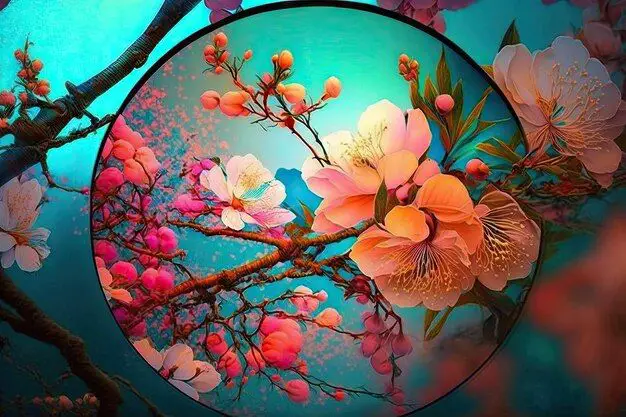Flowers come in a stunning array of colors that add vibrancy and beauty to gardens, floral arrangements, and our lives. The colors that flowers exhibit depend on pigments produced by the plants themselves. By understanding the science behind flower colors, we can better appreciate the diversity found in nature.
Flower Color Pigments
There are three main types of pigments that produce flower color:
- Anthocyanins – Produce red, blue, and purple colors
- Carotenoids – Produce yellow, orange, and red colors
- Betalains – Produce red and yellow colors
These pigments are synthesized by plants through complex biochemical pathways. Their production is influenced by environmental factors like sunlight, temperature, soil chemistry, and genetics.
Anthocyanins
Anthocyanins are water-soluble pigments belonging to the flavonoid class of compounds. Over 600 different anthocyanins have been identified that can produce colors ranging from orange and red to violet and blue.
Some common anthocyanin pigments are:
| Anthocyanin | Color | Examples |
|---|---|---|
| Cyanidin | Red | Red cabbage, roses |
| Delphinidin | Blue/purple | Bluebells, irises |
| Pelargonidin | Orange | Geraniums, zinnias |
| Peonidin | Magenta | Peonies, cranberry |
| Petunidin | Blue/purple | Petunias, blueberries |
The specific anthocyanin present and environmental conditions like pH determine the resulting flower color. More acidic conditions result in redder pigments, while neutral/alkaline conditions produce blue tones.
Carotenoids
Carotenoids are fat-soluble pigments that confer yellow, orange, and red colors. They are synthesized by plants from isoprene units and are chemically related to terpenes. Over 750 natural carotenoids have been identified.
Some common carotenoids in flowers include:
| Carotenoid | Color | Examples |
|---|---|---|
| Lutein | Yellow | Daffodils, marigolds |
| Zeaxanthin | Yellow | Marigolds, peppers |
| Lycopene | Red | Tomatoes, watermelon |
| Beta-carotene | Orange | Carrots, pumpkins |
Carotenoids are responsible for the brilliant yellows prominent in flowers like daffodils, as well as the deeper oranges and reds found in pansies, roses, and poppies.
Betalains
Betalains are nitrogen-containing pigments that produce red and yellow colors in flowers. They are water-soluble pigments derived from the amino acid tyrosine. Betalains are only produced by plants in the order Caryophyllales, which includes cacti and bougainvillea.
The two main types of betalain pigments are:
- Betacyanins – Produce red/violet colors
- Betaxanthins – Produce yellow/orange colors
In most plant species, anthocyanins and betalains are mutually exclusive – meaning a plant will produce one or the other pigment type. This allows betalains to confer some red and purple flower colors not possible with anthocyanins alone.
Other Pigments
In addition to the major pigment classes described above, some other compounds contribute to flower color diversity:
- Chlorophyll – Produces green colors, often masked by other pigments
- Tannins – Produce browns
- Flavones – Modify colors, produce white/cream
- Metal ions – Modify colors, for example magnesium turns anthocyanins blue
The concentration and combination of all these pigments along with cell structure ultimately determine the final vibrant flower colors we observe.
Why Do Flowers Have Color?
Flower color serves multiple biological functions for plants:
- Attract pollinators – Bright colors and patterns guide pollinators like birds, bees, butterflies
- Attract fruit dispersers – Vivid colors signal ripened fruit
- Camouflage – Some orchids mimic female insect pheromones with color
- Deter herbivores – Bright pigments may signal toxicity
- Regulate temperature – Darker pigments can heat flowers
- Block UV rays – Certain pigments protect plant DNA
This diversity of functions has driven the evolution of an enormous range of flower colors spanning the visible spectrum.
Most Vibrant Flower Colors
Some exceptionally brilliant and vibrant flower colors include:
| Color | Flowers | Pigments |
|---|---|---|
| Blue | Hydrangea, iris | Anthocyanins |
| Red | Tulip, poppy | Anthocyanins, carotenoids |
| Orange | Marigold, lily | Carotenoids |
| Yellow | Daffodil, sunflower | Carotenoids |
| Purple | Lavender, orchid | Anthocyanins |
These eye-catching colors are achieved by specialized pigments, sometimes combined with structural properties of the flower petals and sepals themselves. Unique purples arise when blue anthocyanin pigments are combined with red carotenoids.
Achieving Color Harmony
When selecting flowers for arrangements and gardens, color theory principles can help achieve visually pleasing color combinations. Some guidelines include:
- Use warm colors like reds/oranges with cool colors like blues/purples for high-contrast drama
- Combine pastel versions of complementary colors like pale orange and yellow for peaceful mood
- Select flowers with neighboring hues on the color wheel for harmonious arrangements
- Use plants with silver/gray foliage like dusty miller to gracefully transition between colors
- Incorporate white and cream flowers to soften and highlight brighter colors
Nature provides an infinite palette to work with. Take inspiration from brightly colored birds and insects to artfully mix flower pigments.
Conclusion
Flower color is far more complex than simply a matter of aesthetics. A range of pigments, specialized plant structures, and evolutionary pressures give rise to the vibrant colors that bring joy and beauty into our lives. By appreciating the science behind floral hues, we gain a deeper understanding of the natural world.


